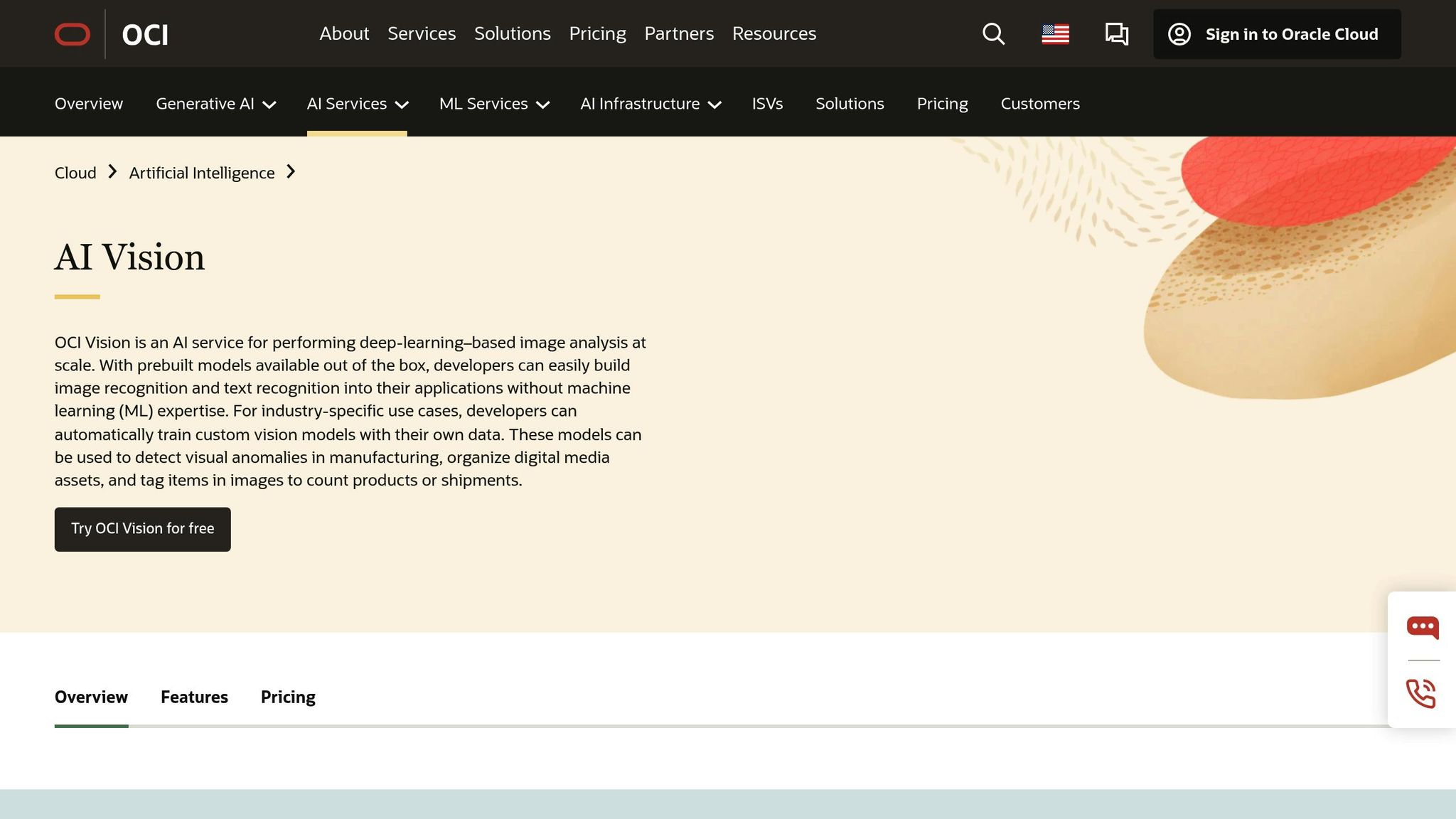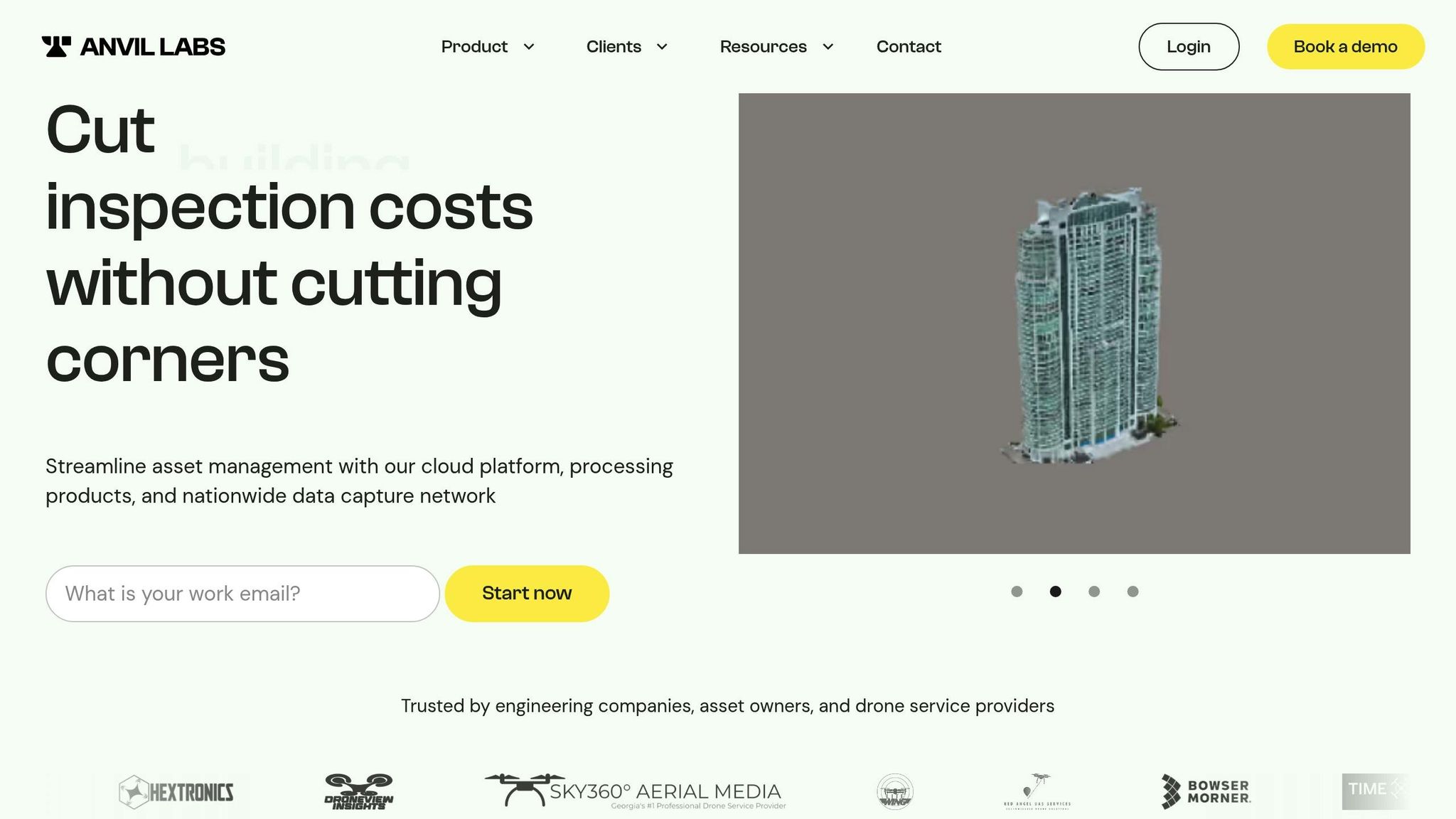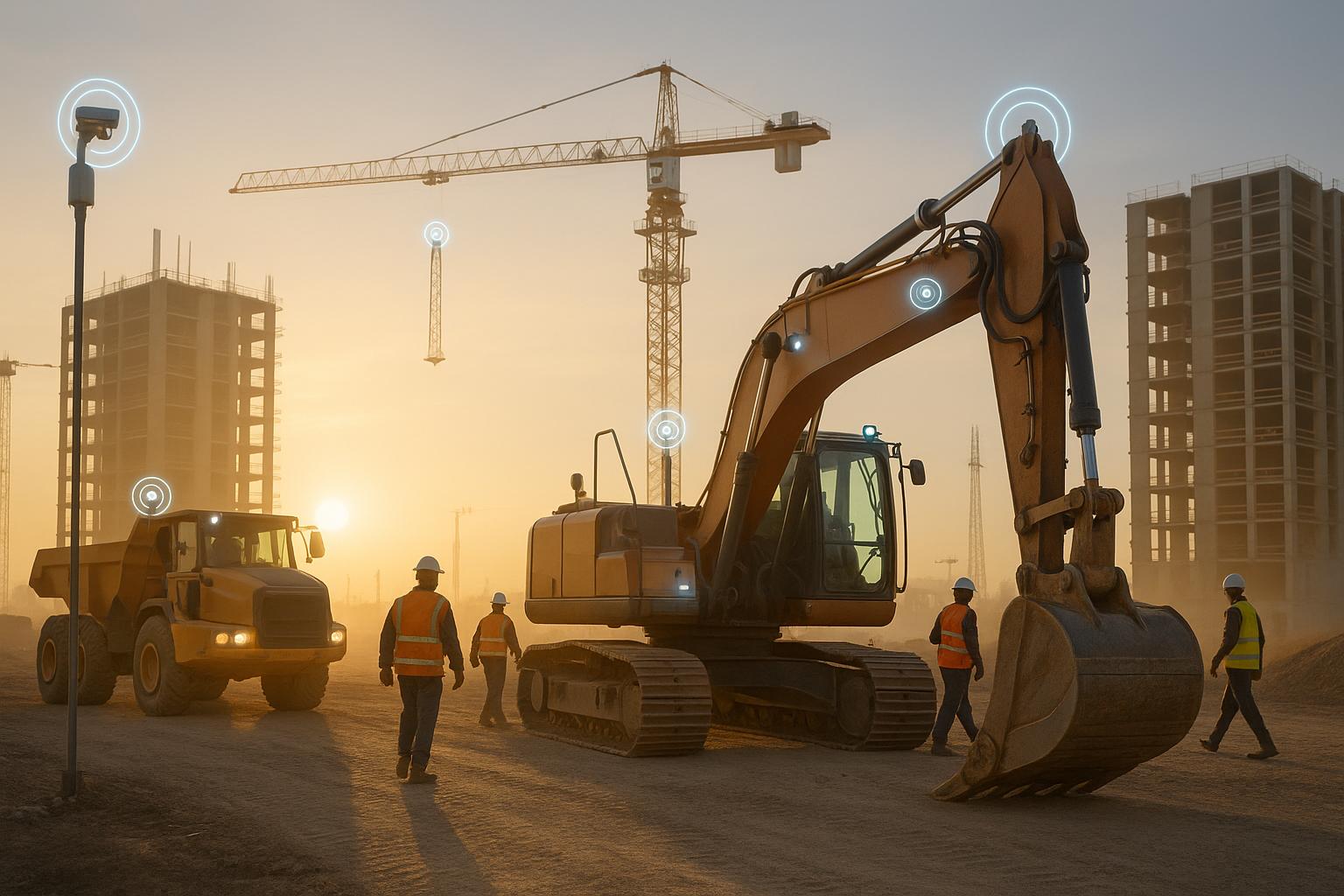Construction sites are complex and risky environments, demanding advanced monitoring to ensure safety and efficiency. Multi-sensor anomaly detection systems are transforming how sites are monitored by integrating data from multiple devices like cameras, accelerometers, and IoT sensors. These systems identify issues early, improve accuracy, and reduce false alarms, saving time and costs.
Key insights:
- Single-sensor systems fall short: They struggle with incomplete data and limited precision.
- Multi-sensor systems excel: They combine diverse data sources for better detection and reduced errors.
- AI-powered tools: Automate analysis, flag anomalies, and provide actionable insights in real-time.
- Challenges: Data integration, real-time processing, and clear result interpretation remain hurdles.
- Solutions like Anvil Labs: Provide centralized platforms, visualization tools, and mobile access for efficient monitoring.
This technology is reshaping construction by improving safety, reducing delays, and cutting costs, with future advancements promising even greater precision and speed.
Automate Defect Detection Using Drones and OCI Vision

Multi-Sensor Construction Monitoring Challenges
Using multi-sensor systems in construction offers many benefits, but they also come with challenges that can impact data accuracy and project timelines. Let’s break down the key hurdles.
Data Integration and Compatibility
Construction sites rely on a variety of sensors - RGB cameras, thermal imagers, LiDAR, accelerometers, and IoT devices - all of which produce data in different formats and resolutions. Integrating this data into a single monitoring system often requires custom solutions, especially when dealing with proprietary formats. On top of that, these sensors operate on different time intervals, making synchronization tricky.
Environmental conditions like rain, dust, or debris can further degrade sensor performance, adding yet another layer of complexity. All of this makes real-time data processing even more demanding.
Real-Time Data Processing
Traditional manual methods for monitoring and analyzing data are slow and can lead to costly delays. With construction sites generating terabytes of data daily, real-time processing requires robust algorithms and powerful computing.
But there’s another challenge: remote construction sites often face limited network bandwidth. Teams are often forced to choose between real-time monitoring and conducting a deeper analysis of the data. Companies like Anvil Labs are tackling this issue with cloud-based platforms that streamline data collection using drones and sensors. Their approach has shown impressive results - 75% faster inspections, 30% more defects detected, and a return on investment within just two months.
Clear Results and Action Steps
Even after overcoming integration and processing challenges, there’s still the issue of translating raw sensor data into actionable insights. Construction teams need results that are easy to understand and prioritize. Intuitive visuals and smart alert systems can help minimize false positives and make on-site decision-making faster and more efficient.
Mobile-friendly platforms are also crucial, enabling site managers to access actionable data wherever they are.
"This is a differentiator. Those that aren't able to provide visualization but are just doing raw footage - this gives you, in my opinion, that competitive edge." - Adrian, Drone Service Provider
Addressing these challenges is key to fully harnessing the power of multi-sensor systems in construction. The best solutions combine advanced data processing with user-friendly interfaces, ensuring that cutting-edge technology translates into meaningful, everyday benefits for construction teams.
AI Solutions for Multi-Sensor Anomaly Detection
AI has transformed the way multi-sensor data is analyzed on construction sites. By automating pattern recognition, identifying anomalies, and delivering actionable insights, AI eliminates the need for extensive manual oversight. These advancements tackle the challenges of integrating data and processing it in real time, which are common hurdles in construction monitoring.
Data Fusion Methods
AI-powered fusion techniques bring together data from multiple sensors to improve safety and monitor structural integrity on construction sites.
Decision-level fusion works by combining the results from individual sensors after they’ve been independently analyzed. For instance, a thermal camera might detect unusual heat patterns in concrete, while a vibration sensor picks up abnormal structural movement. The AI system evaluates both inputs to determine if there’s a genuine structural concern.
Feature-level fusion, on the other hand, merges raw data from multiple sensors before analysis. Take foundation monitoring as an example: data from ground-penetrating radar, accelerometers, and strain gauges is combined to create a detailed view of subsurface conditions and structural responses.
The main benefit of feature-level fusion is its ability to uncover relationships between data types that might go unnoticed when sensors are analyzed separately. However, it demands higher computational power and precise synchronization of data.
Both methods enhance detection accuracy compared to single-sensor systems. Decision-level fusion is particularly effective when sensors have varying sampling rates or when some sensors are temporarily offline. Feature-level fusion shines when subtle anomalies emerge only through the combination of multiple data streams.
Unsupervised Learning Models
Unsupervised learning models analyze sensor data without requiring labeled datasets, making them ideal for dynamic construction environments. These models use techniques like clustering, transformer-based analysis, and autoencoders to detect anomalies.
Clustering algorithms group similar data points, helping to identify outliers. For example, in construction site monitoring, these algorithms learn what "normal" looks like for specific areas. When new data deviates from these patterns, the system flags it for further inspection. This is especially useful for identifying previously unseen problems.
Transformer-based models, originally designed for natural language processing, have proven effective for analyzing time-series data in construction. They excel at recognizing long-term patterns and dependencies, detecting anomalies by comparing current readings to historical trends, seasonal variations, or specific project phases.
The strength of unsupervised learning lies in its adaptability. These models continuously learn and adjust as construction projects evolve, making them perfect for monitoring unique structures or experimental techniques where historical data is scarce.
This advanced anomaly detection enables clear and actionable visual representations.
Visual Tools and Result Explanation
Interactive visualization tools translate complex sensor data into easy-to-understand visuals, empowering teams to make quick, informed decisions.
Heat maps overlay anomaly scores onto 3D site models, pinpointing problem areas at a glance. This eliminates the need to sift through raw sensor data, allowing site managers to focus their attention where it’s needed most.
Time-series charts track changes over time, helping teams determine if an anomaly is a one-off occurrence or part of a larger trend. These visualizations can also reveal correlations between sensors, such as how vibrations from heavy machinery might align with structural stress readings.
Explainable AI features provide transparency by detailing why specific anomalies were flagged. Instead of vague alerts, these systems outline which sensors contributed to the detection and how the data deviates from normal patterns. This clarity helps teams decide whether immediate action is necessary.
Mobile-friendly interfaces ensure that critical updates reach field personnel in real time. Site supervisors can receive alerts with visual context directly on their devices, enabling them to address safety concerns on the spot.
The best visualization tools integrate seamlessly with existing project management systems, offering tailored insights for different roles. High-level dashboards provide executives with an overview of site health, while engineers can dive into detailed sensor data and analysis.
Platforms like Anvil Labs take this a step further by combining 3D models with sensor data, creating user-friendly interfaces that help teams quickly interpret AI-driven insights. These tools turn raw data into practical information, supporting safer and more efficient construction operations.
sbb-itb-ac6e058
Construction Use Cases and Sensor Applications
Using multiple sensors for anomaly detection has transformed how construction sites operate, shifting from manual, periodic checks to continuous, automated monitoring. This shift not only improves project efficiency and productivity but also speeds up decision-making by providing real-time data and a clear picture of site conditions. These tools ensure that critical sensor readings are acted on immediately, making oversight more effective. Let’s dive into how these changes are improving workflow automation on construction sites.
Workflow Automation Improvements
Automating key oversight tasks - like tracking progress and inspecting quality - allows project teams to quickly spot and resolve issues. When real-time sensor data is integrated into project management tools, it simplifies tasks like updating schedules and planning resources, making operations smoother and more efficient.
Multi-Sensor Anomaly Detection with Anvil Labs

Anvil Labs simplifies multi-sensor detection by bringing diverse data types into one platform and streamlining workflows. It provides the infrastructure needed to support advanced monitoring systems, making it easier for construction teams to deploy and manage sensor networks across job sites.
Data Hosting and Processing
Anvil Labs efficiently handles multiple sensor data streams, supporting formats like 3D models, thermal imagery, LiDAR, and orthomosaics for anomaly detection. Teams can upload all these data types into a single, centralized location.
For high-resolution data, optional processing is available at $3 per gigapixel, ensuring smooth handling without storage or processing delays. A standout feature of Anvil Labs is its ability to maintain data integrity across various sensor types. Whether it's 360° panoramas from site cameras or detailed LiDAR scans from structural monitoring tools, the platform ensures spatial accuracy. This precision is essential for AI algorithms to link findings across different sensor inputs, enabling seamless collaboration among team members.
Collaboration Tools and Features
Anvil Labs offers tools for annotation and measurement, making it easy to mark areas of concern on 3D models or thermal images. When a sensor detects an anomaly, team members can annotate the exact location, add measurements, and include notes about potential causes or suggested actions.
To protect sensitive information, the platform includes secure sharing with customizable access controls. Project managers can assign different permission levels - engineers might get full access, while clients or regulatory inspectors receive read-only privileges.
These collaboration features shine in emergencies. For example, if sensors detect structural shifts or temperature anomalies, teams can quickly share annotated data with engineers or safety personnel. Overlaying sensor data on detailed 3D models allows everyone to grasp the context and seriousness of the issue. The platform’s collaborative setup, combined with cross-device access and AI tools, ensures field operations are as efficient as possible.
Cross-Device Access and AI Integration
Construction sites require flexible data access, and Anvil Labs delivers. Project managers can review anomaly alerts on tablets while in the field, while engineers back at the office analyze the same data on desktop workstations.
The platform’s AI integration enhances the anomaly detection process. Teams can link their preferred AI algorithms directly to Anvil Labs, enabling automated analysis of thermal patterns, structural movement, and other complex data trends.
Beyond AI, the platform connects with task management systems, streamlining workflows. When an anomaly is identified, the system can automatically generate work orders or safety alerts in existing project management software, ensuring issues are promptly addressed by field teams.
Anvil Labs also supports Matterport integration, a valuable feature for construction projects using 3D scanning. By combining Matterport’s interior scans with structural monitoring sensor data, teams gain a comprehensive view of both visible conditions and hidden structural behavior.
Pricing starts at $49 per project for basic hosting and sharing, with a $99 per month option that includes full access to hosting, management, and collaboration tools. This flexible pricing structure allows teams to scale their monitoring capabilities based on project needs and budgets.
The Future of Multi-Sensor Anomaly Detection in Construction
Multi-sensor anomaly detection is reshaping safety and project management in construction, delivering measurable results across the country. This progress paves the way for advancements that will solidify the importance of multi-sensor systems in the industry.
Key Points
Streamlined data integration turns massive amounts of sensor output into actionable insights. Construction sites generate data from tools like thermal cameras, LiDAR scanners, structural sensors, and environmental monitors. Platforms such as Anvil Labs bring this data together - overlaying thermal images on 3D models and linking structural and environmental data - to identify issues that single-sensor systems might miss.
AI-driven analysis processes these large datasets, uncovering subtle patterns that human teams might overlook.
Lower costs, higher returns. Anvil Labs offers pricing that starts at $49 per project for basic hosting, with full collaboration tools available for $99 a month. This affordability makes advanced monitoring an option for projects of all sizes. Compared to the potential expenses of structural failures or safety incidents, these tools provide a strong return on investment.
Real-time alerts allow teams to respond quickly, helping to prevent major problems before they escalate.
Future Developments
The next wave of innovation will build on today’s integrated and AI-powered systems, offering even more precision and speed. Sensor technology is advancing rapidly, with devices becoming smaller, more accurate, and less expensive. Edge computing will enable sensors to process data locally, cutting down on delays and improving response times for critical safety notifications.
Emerging systems will combine predictive maintenance with 5G-enabled, high-resolution data streams. This will allow teams to forecast equipment needs and monitor sites in real time, reducing delays and improving safety.
Standardization will make it easier to integrate different sensors, while augmented reality tools will provide on-site visual feedback for identified issues.
With these advancements, paired with platforms that can efficiently manage and analyze multi-sensor data, the construction industry is set to achieve major gains in both safety and operational efficiency in the years ahead.
FAQs
How do multi-sensor systems enhance safety and efficiency on construction sites?
Multi-sensor systems are transforming construction site safety and operations by providing real-time, in-depth insights that help detect hazards early and keep a close eye on site activities. By integrating data from multiple sources, these systems allow for accurate tracking of workers, machinery, and structural conditions. This means safety measures can be taken proactively, significantly lowering the chances of accidents.
Beyond safety, these systems also simplify workflows by automating the process of collecting and analyzing data. This reduces the need for manual effort, saving valuable time. The result? Smarter decisions, boosted productivity, and a safer, more efficient environment for everyone on-site.
What are the biggest challenges in using data from multiple sensors on construction sites?
Integrating and managing data from multiple sensors on construction sites can be a tough nut to crack. Challenges often start with ensuring accurate synchronization between sensors, so the data aligns perfectly in time. Then there’s the task of handling massive data volumes, which can quickly become overwhelming. On top of that, spatial calibration issues can crop up, making precise measurements harder to achieve.
Another hurdle is dealing with different data formats and modalities - think 3D models, thermal images, and LiDAR scans. Combining these without introducing noise or errors requires careful planning. Add to this the need for device compatibility and spotting sensor faults, and it’s clear that reliable monitoring isn’t as straightforward as it might seem. Tackling these obstacles is crucial to enhancing safety and ensuring the structural soundness of construction sites.
How does AI improve anomaly detection and safety monitoring on construction sites?
AI brings a new level of precision to anomaly detection in construction by using machine learning and computer vision. It processes massive datasets like thermal images, 3D models, and video footage to pinpoint issues such as cracks, misalignments, or uneven surfaces. By catching these problems early, construction teams can address structural concerns before they escalate into serious hazards.
In addition to spotting irregularities, AI automates the analysis of complex data, making safety monitoring more effective and project management more efficient. This not only minimizes risks but also boosts site productivity and enhances safety protocols across the board.

